The Hand Massager Market is estimated to be valued at USD 173.5 million in 2025 and is projected to reach USD 251.9 million by 2035, registering a compound annual growth rate (CAGR) of 3.8% over the forecast period.
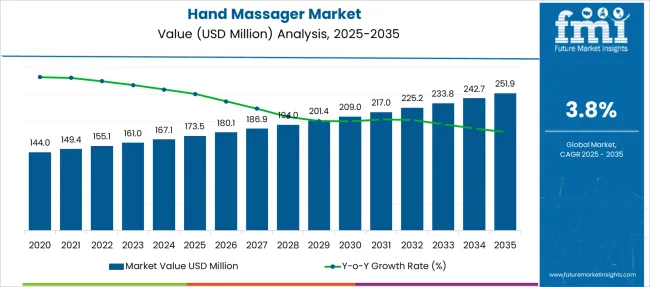
| Metric | Value |
|---|---|
| Hand Massager Market Estimated Value in (2025 E) | USD 173.5 million |
| Hand Massager Market Forecast Value in (2035 F) | USD 251.9 million |
| Forecast CAGR (2025 to 2035) | 3.8% |
The hand massager market is expanding steadily, fueled by rising consumer interest in wellness and self-care products. Increasing awareness about the benefits of hand massage for pain relief and stress reduction has driven demand across personal use segments. The convenience offered by portable and easy-to-use devices has attracted consumers looking for quick therapeutic solutions at home.
Health and lifestyle trends promoting relaxation and recovery have encouraged the adoption of hand massagers. Product innovations emphasizing ergonomic design and multiple massage modes have enhanced user experience.
Furthermore, increased disposable income and changing lifestyles have supported market growth. Distribution through online and offline retail channels has improved product accessibility to a broad consumer base. The market outlook remains positive as consumers continue to seek affordable and effective wellness devices. Segmental growth is expected to be led by battery operated hand massagers, medium price range products, and personal use applications reflecting consumer preferences for portability affordability and individual wellness.
The market is segmented by Product Type, Price Range, End-Use, and Distribution Channel and region. By Product Type, the market is divided into Battery Operated and Plug-in Electric. In terms of Price Range, the market is classified into Medium, Low, and High.
Based on End-Use, the market is segmented into Personal Use and Professional Use. By Distribution Channel, the market is divided into Online, E-commerce Platforms, Company Websites, Offline, Supermarkets/Hypermarkets, Electronics Stores, and Other specialty stores. Regionally, the market is classified into North America, Latin America, Western Europe, Eastern Europe, Balkan & Baltic Countries, Russia & Belarus, Central Asia, East Asia, South Asia & Pacific, and the Middle East & Africa.
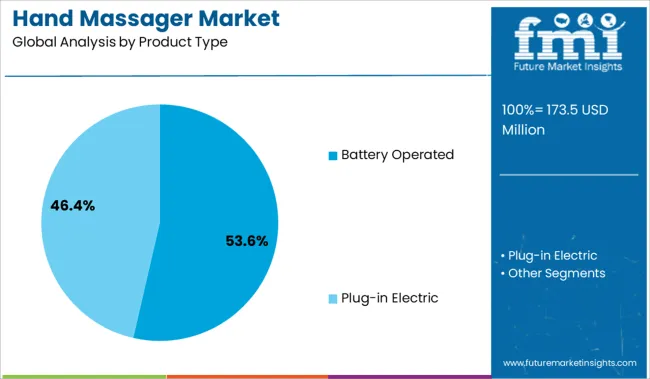
The battery operated segment is projected to contribute 53.6% of the hand massager market revenue in 2025, retaining its leading position among product types. This segment has grown due to the portability and convenience offered by battery-powered devices allowing users to benefit from massage therapy anywhere. The ease of cordless operation has appealed to busy consumers seeking flexible pain relief solutions without being tethered to power outlets.
Battery operated hand massagers are commonly designed with rechargeable batteries enhancing user convenience and device longevity. This segment’s popularity is further supported by the availability of diverse models offering multiple massage techniques and adjustable intensity settings.
With increasing demand for on-the-go wellness products, battery operated hand massagers are expected to maintain dominance.
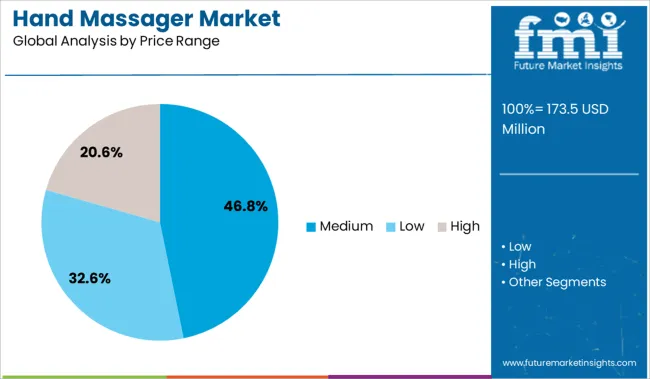
The medium price range segment is projected to account for 46.8% of the market revenue in 2025, establishing itself as the preferred pricing category. Consumers have favored this segment as it offers a balance between quality features and affordability. Products in this range typically provide effective massage performance with durable build quality making them attractive for the majority of buyers.
Competitive pricing strategies and frequent promotions in this price bracket have enhanced accessibility. Furthermore, consumer research indicates growing willingness to invest moderately in personal wellness devices that deliver consistent results.
The medium price range segment benefits from broad market appeal and is expected to sustain its leading revenue share.
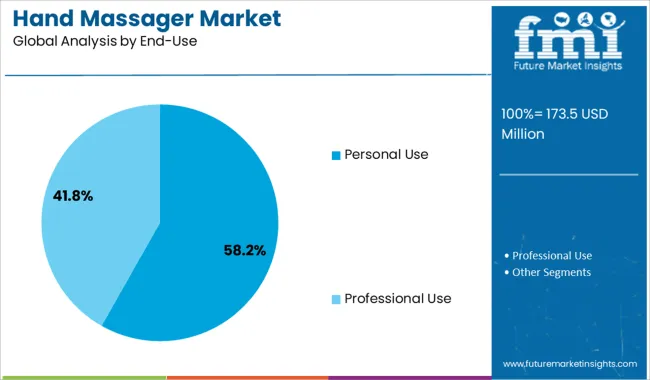
The personal use segment is projected to hold 58.2% of the hand massager market revenue in 2025, remaining the largest end-use category. This segment’s growth has been driven by consumers increasingly incorporating hand massagers into their daily self-care and wellness routines. The rise in remote work and sedentary lifestyles has amplified the need for convenient tools to relieve hand fatigue and improve circulation.
Personal users have preferred compact and easy-to-operate devices suitable for home use. Marketing efforts focusing on the therapeutic benefits of hand massage for conditions like arthritis and carpal tunnel syndrome have strengthened consumer adoption.
As wellness trends continue to prioritize individual health and comfort, the personal use segment is expected to remain dominant in the market.
Growing awareness of home wellness, rising musculoskeletal discomfort, and preventive care interest fuel demand. Opportunities include ergonomic designs, smart features, and partnerships with clinics and retailers to reach broader consumers.
The hand massager market is expanding as more people experience muscle fatigue, joint stiffness, arthritis, and tendon-related discomfort. Aging demographics contribute too—seniors increasingly seek non-pharmaceutical pain relief at home. Occupational trends such as repetitive hand movements, long computer use, and manual labor spur interest in therapeutic devices. Preventive health behavior is also on the rise, with users preferring devices they can safely use independently. Clinics, physiotherapists, and wellness centers recommend hand massagers as part of recovery regimens. Globally, the prevalence of hand-related ailments in both working professionals and older adults is positioning this product category as a go-to for accessible relief and everyday recovery.
Growth opportunities lie in developing handheld massagers with ergonomic contours, adjustable intensity levels, and heat or vibration options tailored to user needs. Combining portable design with smart features—beyond standard operation—like app-based control, usage tracking, and therapy reminders adds value. Bundled offers with wellness centers, physiotherapy clinics, and online health platforms can boost credibility and reach. Retailers and gift platforms offer additional distribution avenues, especially for stress-relief and self-care positioning. Emerging markets also represent untapped potential as affordability improves and awareness spreads. Manufacturers focusing on user comfort, device portability, and reliable after-sales support can meet growing demand in both clinical and home environments.
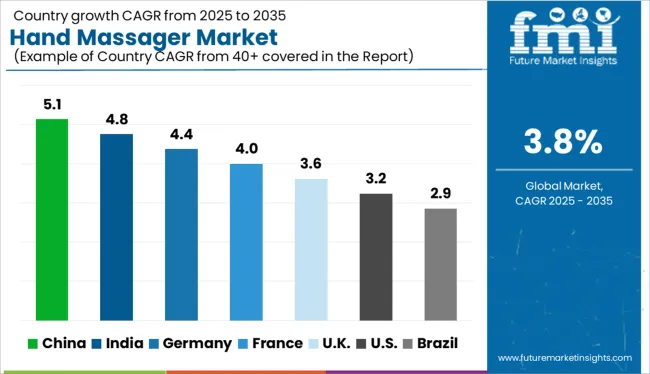
| Country | CAGR |
|---|---|
| India | 4.8% |
| Germany | 4.4% |
| France | 4.0% |
| UK | 3.6% |
| USA | 3.2% |
| Brazil | 2.9% |
The global hand massager market is projected to grow at a CAGR of 3.8% from 2025 to 2035, driven by increasing awareness of hand fatigue, stress relief, and home wellness solutions. Among BRICS countries, China leads with a 5.1% CAGR, supported by strong e-commerce penetration, tech-integrated wellness devices, and growing domestic demand. India follows at 4.8%, fueled by rising disposable income, ergonomic health awareness, and affordable product availability. In the OECD region, Germany shows solid growth at 4.4%, with innovation in electric massagers and aging population-driven demand. The United Kingdom (3.6%) and the United States (3.2%) reflect slower growth due to market maturity, but consistent demand remains through wellness-focused retail and online channels. This report covers detailed analysis of 40+ countries, and the top five countries have been shared as a reference.
Between 2025 and 2035, the hand massager market across China is projected to grow at a CAGR of 5.1%, with annual growth ranging from 4.8% to 5.4%. Rising stress levels in urban populations and increasing disposable income are driving consumer interest in home-based wellness devices. With a growing elderly demographic and higher smartphone usage contributing to hand fatigue, demand is surging across both younger and older age groups. Retailers are expanding online and offline distribution channels, making smart massagers more accessible nationwide. Tech-integrated models with heating and vibration features are especially gaining popularity.
From 2025 to 2035, the hand massager market across India is set to grow at a CAGR of 4.8%, with year-over-year growth varying between 4.4% and 5.2%. Increasing focus on personal wellness and the popularity of at-home therapy solutions are fueling demand. Rising work-from-home culture has brought more awareness to repetitive strain injuries and hand fatigue, especially among professionals and students. Domestic brands are offering affordable, compact devices suited to small living spaces, making them accessible to a broader consumer base. The gifting market is also contributing to volume growth during festive seasons.
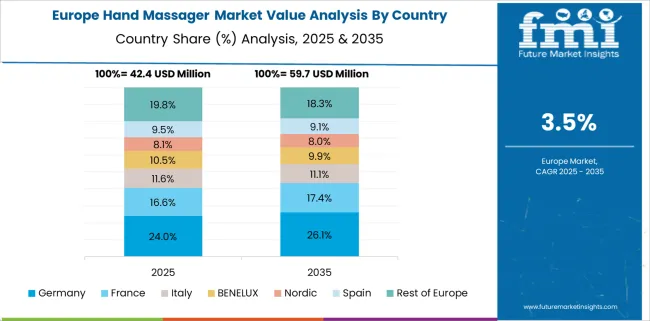
Hand massager market in Germany is forecast to grow at a CAGR of 4.4% during 2025 to 2035, with yearly growth ranging from 4.1% to 4.7%. A strong wellness culture and demand for ergonomic health tools are contributing to steady expansion. With increasing screen time and rising cases of carpal tunnel syndrome, individuals are turning to home-use massage devices for preventive care. High standards for design and durability are shaping the market, encouraging premium European and Japanese brands to maintain a foothold. Interest in eco-friendly and rechargeable models is also increasing.
Across the United Kingdom, the hand massager market is expected to expand at a CAGR of 3.6% between 2025 and 2035, with year-over-year growth ranging from 3.3% to 3.9%. Consumers are increasingly exploring non-invasive therapies for joint relief and hand mobility, especially among aging and wellness-conscious populations. Home wellness products are gaining visibility through online wellness retailers and influencer-driven marketing. Demand is also increasing in professional circles such as massage therapists, physiotherapists, and wellness clinics. Rising healthcare costs are nudging individuals toward cost-effective self-care alternatives.
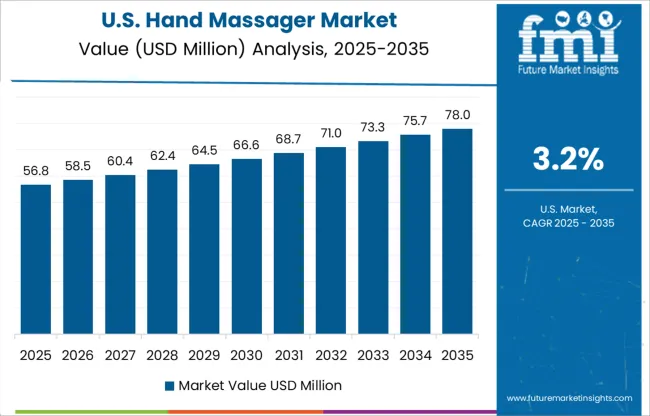
Between 2025 and 2035, the hand massager market across the United States is forecast to grow at a CAGR of 3.2%, with annual growth between 2.9% and 3.5%. Interest in personal care technology is expanding as users seek relief from hand tension related to digital device overuse. Massagers with programmable settings, compression, and heat therapy are in demand, especially in middle-aged and tech-comfortable households. Retailers are bundling hand massagers with wellness kits and ergonomic accessories. The aging baby boomer population is another significant contributor to sustained market growth.
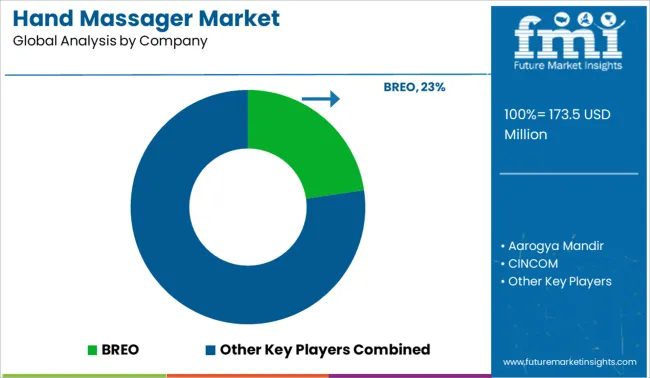
The hand massager market is fragmented, with numerous global and regional brands competing on features, price, and wellness benefits. Tier 1 player BREO leads with a 22.7% market share, driven by product innovation, ergonomic design, and a strong presence in premium health and wellness segments. Tier 2 brands like CINCOM, Comfier, and Lifepro offer mid-range massagers with features such as heat therapy, compression, and portability, catering to both therapeutic and relaxation use cases. Tier 3 companies including Aarogya Mandir, JSB Wellness, KNQZE, and Lunix serve regional markets with budget-friendly options, often distributed through e-commerce and health retail channels. Market demand is fueled by rising stress-relief needs, aging populations, and increasing consumer interest in at-home wellness devices.
| Item | Value |
|---|---|
| Quantitative Units | USD 173.5 Million |
| Product Type | Battery Operated and Plug-in Electric |
| Price Range | Medium, Low, and High |
| End-Use | Personal Use and Professional Use |
| Distribution Channel | Online, E-commerce Platforms, Company Websites, Offline, Supermarkets/Hypermarkets, Electronics Stores, and Other specialty stores |
| Regions Covered | North America, Europe, Asia-Pacific, Latin America, Middle East & Africa |
| Country Covered | United States, Canada, Germany, France, United Kingdom, China, Japan, India, Brazil, South Africa |
| Key Companies Profiled | BREO, Aarogya Mandir, CINCOM, Comfier, Cotsoco, Daiwa Felicity, JSB Wellness, KNQZE, Lifepro, and Lunix |
| Additional Attributes | Dollar sales by product type (electric, manual, air compression, thermal), application (arthritis relief, muscle relaxation, circulation improvement, stress reduction), and distribution channel (online retail, specialty stores, pharmacies); regional consumer behavior driven by aging populations and wellness trends; pricing sensitivity across income brackets and device sophistication; innovation in ergonomic design, portability, and smart connectivity features; regulatory considerations for therapeutic claims; environmental impact of electronic waste and material use; and emerging use cases in workplace wellness and physical therapy. |
The global hand massager market is estimated to be valued at USD 173.5 million in 2025.
The market size for the hand massager market is projected to reach USD 251.9 million by 2035.
The hand massager market is expected to grow at a 3.8% CAGR between 2025 and 2035.
The key product types in hand massager market are battery operated and plug-in electric.
In terms of price range, medium segment to command 46.8% share in the hand massager market in 2025.






Full Research Suite comprises of:
Market outlook & trends analysis
Interviews & case studies
Strategic recommendations
Vendor profiles & capabilities analysis
5-year forecasts
8 regions and 60+ country-level data splits
Market segment data splits
12 months of continuous data updates
DELIVERED AS:
PDF EXCEL ONLINE
Hand Towel Automatic Folding Machine Market Size and Share Forecast Outlook 2025 to 2035
Handheld Ultrasound Scanner Market Size and Share Forecast Outlook 2025 to 2035
Handheld Tagging Gun Market Forecast and Outlook 2025 to 2035
Handheld Imaging Systems Market Size and Share Forecast Outlook 2025 to 2035
Hand Tools Market Size and Share Forecast Outlook 2025 to 2035
Handloom Product Market Size and Share Forecast Outlook 2025 to 2035
Handheld XRF Analyzers Market Size and Share Forecast Outlook 2025 to 2035
Handheld Police Radar Guns Market Size and Share Forecast Outlook 2025 to 2035
Handheld DNA Reader Market Size and Share Forecast Outlook 2025 to 2035
Handheld Robotic Navigation Market Analysis - Size, Share, and Forecast Outlook 2025 to 2035
Handheld Mesh Nebulizer Market Size and Share Forecast Outlook 2025 to 2035
Hand & Arm Protection (PPE) Market Size and Share Forecast Outlook 2025 to 2035
Handwheels Market Size and Share Forecast Outlook 2025 to 2035
Handheld Chemical and Metal Detector Market Size and Share Forecast Outlook 2025 to 2035
Hands-Free Safety Tools Market Size and Share Forecast Outlook 2025 to 2035
Hand-held Breast Cancer Detection Market Analysis Size and Share Forecast Outlook 2025 to 2035
Handheld Dental X-Ray Systems Market Analysis - Size, Share, and Forecast 2025 to 2035
Hand Dryer Market Size and Share Forecast Outlook 2025 to 2035
Hand Blender Market Size and Share Forecast Outlook 2025 to 2035
Hand Sanitizer Spray Pen Market Size and Share Forecast Outlook 2025 to 2035

Thank you!
You will receive an email from our Business Development Manager. Please be sure to check your SPAM/JUNK folder too.
Chat With
MaRIA